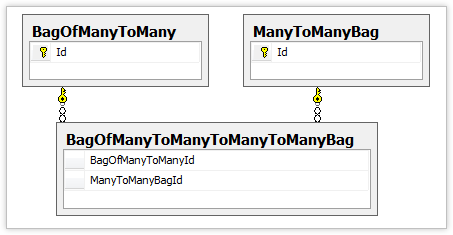系列引入
NHibernate3.0剖析系列分别从Configuration篇、Mapping篇、Query篇、Session策略篇、应用篇等方面全面揭示NHibernate3.0新特性和应用及其各种应用程序的集成。基于NHibernte3.0版本号。
假设你还不熟悉NHibernate,能够高速阅读NHibernate之旅系列文章导航系列入门,假设你已经在用NHibernate了,那么请跟上NHibernate3.0剖析系列吧。
- NHibernate专题:http://kb.cnblogs.com/zt/nhibernate/
- NHibernate官方网站:http://nhforge.org/
- NHibernate參考文档:http://nhforge.org/doc/nh/en/
- 获取NHibernate地址:http://sourceforge.net/projects/nhibernate/
Bag映射
这节我们介绍Bag映射,一般而言,Domain中的System.Collections.Generic.ICollection<T>集合类型使用Bag来映射。
映射纲要
Bag映射与Set映射一样。有两个部分:集合外键(Collection foreign keys)和集合元素(Collection element)。
集合外键(Collection foreign keys)。通过<key>映射。其column属性命名方式一般採用"集合持有者类名+Id"命名方式。
集合元素(Collection element),即集合中的对象:
- 值类型,其声明周期全然依赖于集合持有者。通过<element>或<composite-element>映射。
- 引用类型,被作为集合持有的状态考虑的。仅仅有两个对象之间的“连接”,具有其自己的生命周期。通过<one-to-many>或<many-to-many>映射。
案例分析
案例一:BagOfElements
Domain定义中,集合元素通常是单一元素(Elements)类型。即.Net基本类型(string、int、double等等)。
//Code Snippets Copyright http://lyj.cnblogs.com/
public class BagOfElements
{
public int Id { get; set; }
public ICollection<string> Elements { get; set; }
}
映射简单写法:
//Code Snippets Copyright http://lyj.cnblogs.com/
<class name="BagOfElements">
<id name="Id" type="Int32">
<generator class="hilo" />
</id>
<bag name="Elements" table="BagOfElementsElements">
<key column="BagOfElementsId" />
<element type="String" />
</bag>
</class>
单一元素类型在NHibernate中使用<element>映射的,我们应该至少指定column和type类型。假设column没指定,NHibernate提供默认列名id。
数据库架构:
案例二:BagOfComponents
Domain定义中。集合元素通常是组件(Component)类型。也就是值类型。
//Code Snippets Copyright http://lyj.cnblogs.com/
public class BagOfComponents
{
public int Id { get; set; }
public ICollection<ComponentBag> Components { get; set; }
}
public class ComponentBag
{
public string StringProperty { get; set; }
public int IntProperty { get; set; }
}
映射简单写法:
//Code Snippets Copyright http://lyj.cnblogs.com/
<class name="BagOfComponents">
<id name="Id" type="Int32">
<generator class="hilo" />
</id>
<bag name="Components">
<key column="BagOfComponentsId" />
<composite-element class="ComponentBag">
<property name="StringProperty" />
<property name="IntProperty" />
</composite-element>
</bag>
</class>
组件(Component)类型使用composite-element映射,须要指明组件类名。然后映射其组件属性。
数据库架构:
案例三:BagOfComponentsWithParent
Domain定义中,集合元素通常是组件(Component)类型。这个组件关联了其持有者。
//Code Snippets Copyright http://lyj.cnblogs.com/
public class BagOfComponentsWithParent
{
public int Id { get; set; }
public ICollection<ComponentsWithParent> ComponentsWithParents { get; set; }
}
public class ComponentsWithParent
{
public BagOfComponentsWithParent Owner { get; set; }
public string StringProperty { get; set; }
public int IntProperty { get; set; }
}
映射简单写法:
//Code Snippets Copyright http://lyj.cnblogs.com/
<class name="BagOfComponentsWithParent">
<id name="Id" type="Int32">
<generator class="hilo" />
</id>
<bag name="ComponentsWithParents">
<key column="BagOfComponentsWithParentId" />
<composite-element class="ComponentsWithParent">
<parent name="Owner" />
<property name="StringProperty" />
<property name="IntProperty" />
</composite-element>
</bag>
</class>
数据库架构:
案例四:BagOfNestedComponentsWithParent
Domain定义中,集合元素通常是组件(Component)类型,这个组件关联了其持有者而且嵌套了一个组件类型。
//Code Snippets Copyright http://lyj.cnblogs.com/
public class BagOfNestedComponentsWithParent
{
public int Id { get; set; }
public ICollection<NestedComponents> NestedComponents { get; set; }
}
public class NestedComponents
{
public BagOfNestedComponentsWithParent Owner { get; set; }
public string StringProperty { get; set; }
public NestedComponentsWithParent NestedComponentsWithParent { get; set; }
}
public class NestedComponentsWithParent
{
public NestedComponents OwnerNestedComponent { get; set; }
public int IntProperty { get; set; }
}
映射简单写法:
//Code Snippets Copyright http://lyj.cnblogs.com/
<class name="BagOfNestedComponentsWithParent">
<id name="Id" type="Int32">
<generator class="hilo" />
</id>
<bag name="NestedComponents">
<key column="BagOfNestedComponentsWithParentId" />
<composite-element class="NestedComponents">
<parent name="Owner" />
<property name="StringProperty" />
<nested-composite-element class="NestedComponentsWithParent">
<parent name="OwnerNestedComponent" />
<property name="IntProperty" />
</nested-composite-element>
</composite-element>
</bag>
</class>
数据库架构:
案例五:BagOfOneToMany
Domain定义中,集合元素是指向还有一个实体OneToManyBag的引用。这里设置为一对多关系。
//Code Snippets Copyright http://lyj.cnblogs.com/
public class BagOfOneToMany
{
public int Id { get; set; }
public ICollection<OneToManyBag> OneToMany { get; set; }
}
public class OneToManyBag
{
public int Id { get; set; }
}
映射简单写法:
//Code Snippets Copyright http://lyj.cnblogs.com/
<class name="BagOfOneToMany">
<id name="Id" type="Int32">
<generator class="hilo" />
</id>
<bag name="OneToMany">
<key column="BagOfOneToManyId" />
<one-to-many class="OneToManyBag" />
</bag>
</class>
<class name="OneToManyBag">
<id name="Id" type="Int32">
<generator class="hilo" />
</id>
</class>
我们为BagOfOneToMany和OneToManyBag定义一对多关系。使用<one-to-many>映射,指明关联的对象。
数据库架构:
案例六:BagOfManyToMany
Domain定义中。集合元素是指向还有一个实体ManyToManyBag的引用。这里设置为多对多关系。
//Code Snippets Copyright http://lyj.cnblogs.com/
public class BagOfManyToMany
{
public int Id { get; set; }
public ICollection<ManyToManyBag> ManyToMany { get; set; }
}
public class ManyToManyBag
{
public int Id { get; set; }
}
映射简单写法:
//Code Snippets Copyright http://lyj.cnblogs.com/
<class name="BagOfManyToMany">
<id name="Id" type="Int32">
<generator class="hilo" />
</id>
<bag name="ManyToMany" table="BagOfManyToManyToManyToManyBag">
<key column="BagOfManyToManyId" />
<many-to-many class="ManyToManyBag" column="ManyToManyBagId" />
</bag>
</class>
<class name="ManyToManyBag">
<id name="Id" type="Int32">
<generator class="hilo" />
</id>
</class>
两个对象的多对多关系。须要一个“中间表”来存储这两个对象的关系。
数据库架构:
结语
開始NH剖析的Mapping篇,这篇文章介绍NHibernate中的集合映射之Bag映射。
希望本文对你有所帮助。





